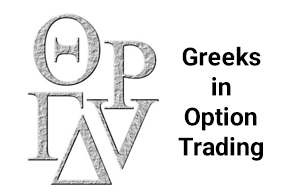Greeks in Option Trading
Published by Sharekhan Education | June 2, 2022

Greeks in Option Trading
Behzad Elavia | Sharekhan Education
In the previous article on basic of options, we learnt the usage of options with respect to the underlying asset (Equity) having a limited span life termed as Expiry. In today’s article, we shall discuss the advantages and the mindset of a trader using Greeks while taking an option position.
What are Greeks?
While we consider an option position, there are various parameters like volatility, direction, strike prices, time value, intrinsic value etc., which float with the underlying asset. Thus, with the above parameters, we can use Greeks to measure the rate/speed at which to achieve the maximum profit.
Power of Greeks using appropriate strike prices:
It is very important for any option trader to focus/choose the appropriate strike price as the movement is based on the underlying. A trader can choose ITM/ATM/OTM strikes based on the premium they are likely to pay/receive. While entering a directional/non-directional strategy Greeks helps us to judge the volatility and the decay; in turn resulting into a profitable/calculated pay-off.
Greeks for Directional Stock: –
The faster the move in a directional stock, OTM strikes are profited the most.
The slower the move in a directional stock, ITM strikes are profited the most.
Greeks for Non-Directional Stock: –
Generally, when entering any strategy, we restrict ourselves to limited profit, typically assumed to be around 2-4%, as our view is fixed or limited. However, if the stock moves beyond our calculated limits due to uncertainties, losses are also limited. Therefore, the term “strategy” yields limited profits or losses.
Types of Greeks
Delta: Delta of an option is measured as the rate at which the underlying speeds up. Generally, for a call option the delta should be positive and closer towards 1, hence, if the underlying increases by Rs.1, the value of a CE should also inflate closer to 1.
Similarly, for a put option the delta should be negative and closer towards -1, hence, if the underlying decreases by Rs.1, the value of a PE should also inflate closer to 1.
Note: ITM options have better deltas than OTM’s.
Gamma: It is considered as a sub-product of delta. The rate change of delta depends on the gamma number. The higher the gamma, delta is better. High spikes in underlying with higher gamma in ATM strikes work better than OTM/ITM strikes.
Theta: Theta is referred as the time value to the maturity of the option contract. The ATM/OTM contracts tend to become zero/lose the entire premium during the time of settlement. Every single day the value of the option decreases as it inherits Theta, thus, a trader has to be very particular while selecting the strikes of the underlying.
Rho: Relatively, it is the least significant than the above, as this Greek involves the calculations of change in interest rates for the underlying which are very rare. Assuming if the interest rate changes by 0.5%, then, the Rho amount would also change proportionately by the driven number.
Benefits of Greeks:
Novice traders struggle with grasping Greeks as strike fluctuations may not sync with the underlying. Greeks measure risk and stabilize exposure/portfolio.
This was about Option trading. For a better understanding of Option trading and other trading concepts visit us on Sharekhan Education. Go through our extensive courses and pick out the one that best caters to your needs!




